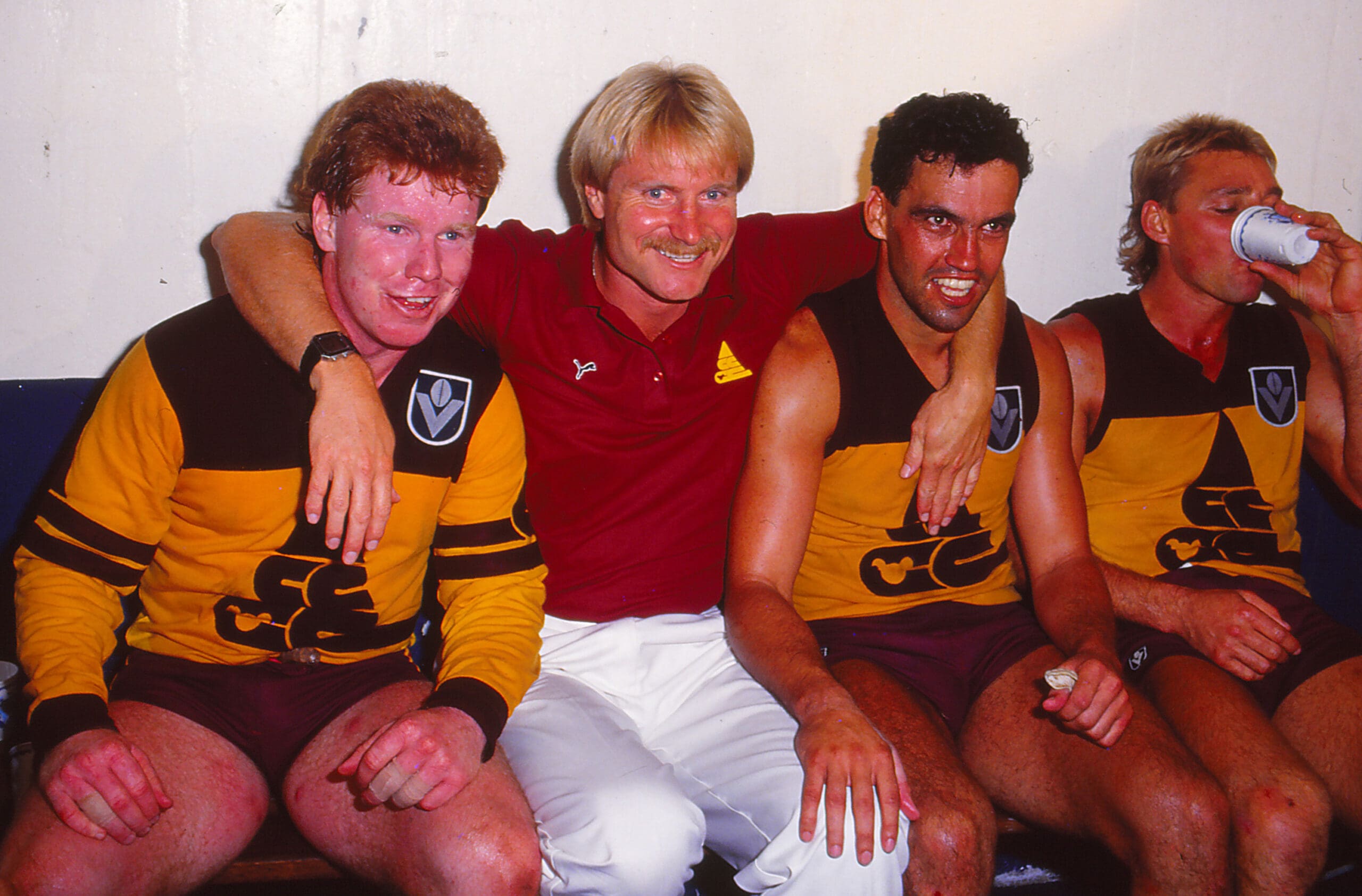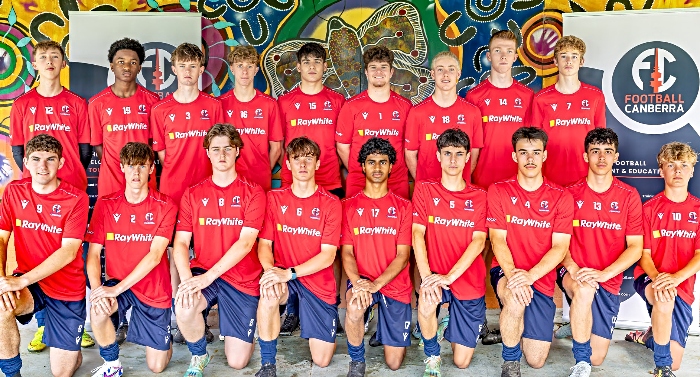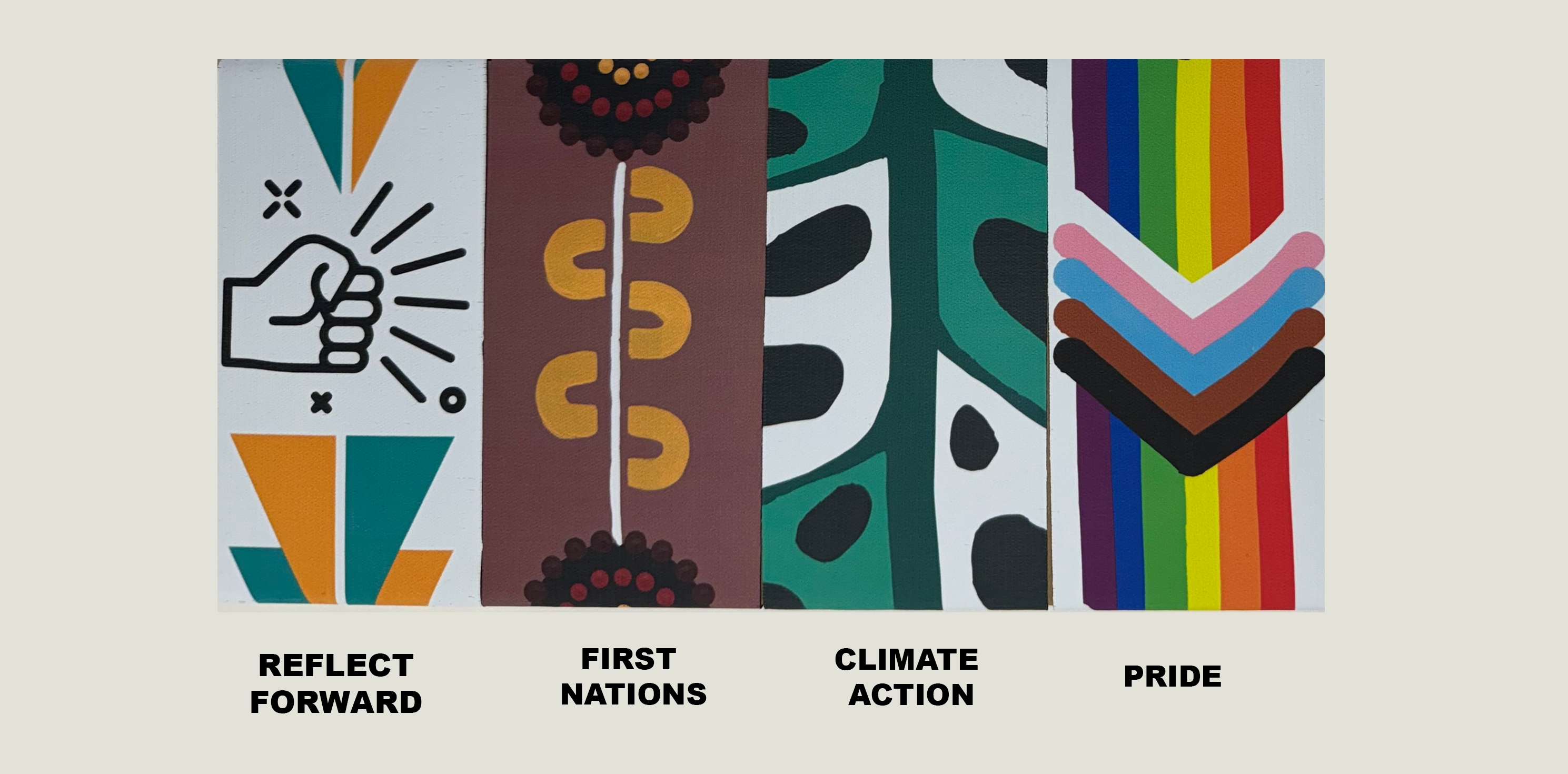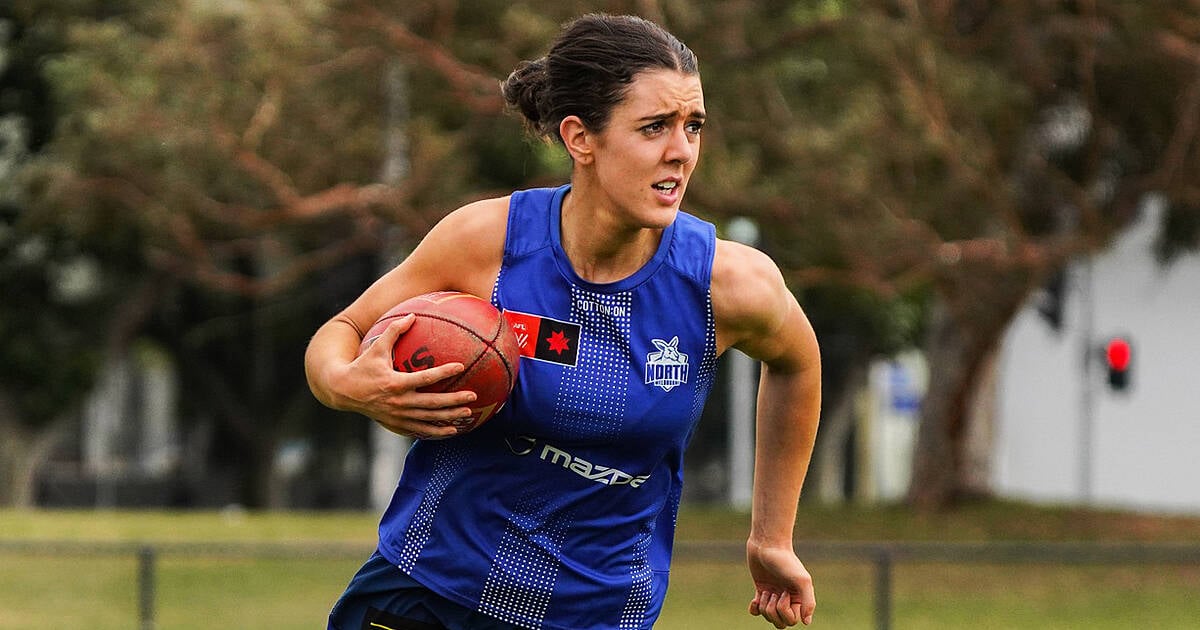How the ‘Bad News Bears’ somehow defied the odds

- by Admin
- July 8, 2024

Former Hawthorn champion Peter Knights was just about done with footy in late 1986.
Knights had given his all for the Hawks on the field – an eventual AFL Hall of Fame-worthy career that included three premierships, two Peter Crimmins trophies and a remarkable three Mark of the Year honours – before retiring in 1985. In 1986, he transitioned to become assistant coach under Allan Jeans, which resulted in yet another premiership for the VFL’s most dominant team of the ’80s.
But after those celebrations subsided, Knights planned a dramatic lifestyle change – a move to South Australia, away from the bright lights of the MCG and Waverley Park.
“In 1986, I’d just finished the season as assistant coach with Hawthorn and we’d won the premiership. At that time, I was still working full-time and footy was very much a past-time. So we finished the season and I was in the process of actually leaving the state – I’d organised schooling and a house in South Australia, and my wife and son were about to move to Adelaide to start up virtually a new life,” Knights told Zero Hanger’s AFL Team Builders podcast.
“But shortly after that I got a phone call from Shane O’Sullivan.”
That phone call from O’Sullivan not only changed the trajectory of Knights’ life, but it also got the ball rolling for one of Australian football’s most seismic events and almost incomprehensible challenges – the establishment of the Brisbane Bears in 1987.
At that point in time, the VFL was dominant among the football leagues around Australia in terms of attendance, interest and money, but many of the competition’s weaker clubs were in dire financial situations. Relocations, mergers and even bankruptcy were all regular topics of conversation among league and club heavyweights, with the South Melbourne Swans eventually forced to relocate to Sydney in 1982.
WATCH: How Souths move north changed footy forever
The league found itself in a complex situation; it needed a huge cash injection to solidify its clubs, but it also wanted to expand into new markets to make the competition a national one. So the VFL decreed that any new clubs would have to pay a license fee of $4 million – a huge sum back in the late ’80s, which the league planned to spread among its struggling clubs and help turn the sport into an Australian-wide code.
Initially, Adelaide and Perth seemed the most natural fits for start-up clubs thanks to the strength of the SANFL and WAFL competitions respectively. But while West Coast jumped at the chance to join the VFL, the South Australian bid failed, mainly due to the SANFL baulking at the costs involved.
So attention turned to Queensland, where Australian football was about as entrenched and popular as European Handball.
Eventually, a consortium headed by former actor Paul Cronin and bankrolled by charismatic but flawed entrepreneur Christopher Skase was awarded the Brisbane licence.
O’Sullivan was serving as Footscray’s General Manager of Football when he was lured north to help lead this expedition into foreign land. He had about five months to sign a coach, build a playing list, establish facilities, find housing and employment for the semi-professional players who did move, and much more.
“It was a great opportunity, I thought, to get footy in the northern states,” he says.
“I was surprised at the lack of real organisation when I got the job. Once I was appointed, I asked a lot of questions, but it was up to myself to make it happen.”
Signing a coach was O’Sullivan’s primary focus once he took on the job as Brisbane’s inaugural GM of Football. His long-standing history with Knights – the pair grew up in similar circles in Gippsland – not to mention the former Hawthorn superstar’s “integrity and work ethic,” according to O’Sullivan, meant it was an obvious call to make.
Knights, who had already started planning for a life away from football, was intrigued and excited by the prospect of building something from the ground up. But the enormity of the challenge soon became obvious.
“I was just blown away,” he says. “The first couple of questions I asked Shane were ‘where’s this team going to be based? Where’s our training base? What’s this new team going to be called? Where’s our training facility going to be? What’s our guernsey? What are we going to be known as? What are our colours?’
“Well, none of that had been organised yet – this was five months before the 1987 season began.
“My final question was ‘OK, who are some of the players who are going to be playing, who I will be coaching’? Well, we didn’t have any players yet either.
“But it all sounded really exciting. Not many people get to go and start a club from scratch. The excitement of being the first coach with this new, embryonic footy club in a foreign land such as Queensland was exciting.
“I did have to talk to some of the people who I hold closely – my three coaches at Hawthorn were the legendary John Kennedy, David Parkin and Allan Jeans, so I had conversations with them, basically to ask them ‘do you think I’m up for it?’ because at that stage, I’d only had one year as an assistant coach under Jeans.
“But each one of them said it was such a wonderful opportunity, give it a go! So that began to get the wheels in motion.”
The wheels may have been in motion, but in reality, they were awfully close to veering off track throughout the lead-in to their inaugural season in 1987.
The list build was a case in point. Far from the concessions handed out to modern AFL start-ups like Greater Western Sydney and Gold Coast, the Bears could only cobble together a handful of genuine VFL players, coupled with the pick of local Queensland talent, which, back in the late 1980s, left much to be desired.
True Trailblazers: How the Swans thrived in Sydney after almost being ripped apart
Collingwood captain Mark Williams and 1985 Brownlow medallist Brad Hardie were the headline recruits, supported by Geoff Raines and Ken Judge. The inaugural captain was ruckman Mark Mickan, recruited out of the SANFL, although O’Sullivan remembers Mickan’s career at the Bears almost finishing before it started.


“Mark Mickan, we were going to appoint him captain of the team; we hadn’t told anybody but he came to me a couple of days before we were going to announce it and he said ‘look, I’m homesick – I want to go home’,” O’Sullivan said.
“And I thought ‘holy hell’. So I immediately got ‘Knightsy’ and Ken Murphy, who was the CEO, and together we talked him round. But those were the sort of issues we had in those early days.”
The shadow of Skase – one of Australia’s most controversial businessmen, and later, fugitives – loomed large in those early days, for better, and often, for worse.
With the fledgling club doing all it could to make its mark on the Brisbane sporting landscape – a tough enough job to start with – Skase’s decision to play out of Carrara Oval on the Gold Coast proved to be a disaster, and one which took years to recover from.
O’Sullivan remembers the move to Carrara creating a huge disconnect between the club and the people it wanted to reach – namely fans, media organisations and corporate entities.
“It was certainly a mistake – you have to play where the population is. But we got called to Christopher’s boardroom, with all the players and families, and everyone got told we’re going to be permanently playing down at Carrara, which certainly threw the cat amongst the pigeons,” he said.
“Everyone got pretty upset because so many people had either bought or were renting (properties) in Brisbane and to think you had to drive down to Carrara for games and training as well, it made things a bit awkward.
“It was disappointing – we were certainly hoping to play at the Gabba, but it wasn’t to be.”
In O’Sullivan’s mind, it was a decision Skase didn’t make with the club, or the code’s, best interests at heart; rather just a way to boost the bottom line of his iconic Sheraton Grand Mirage Resort hotel just north of Surfers Paradise.
“I think it was perhaps his Mirage Resort which made him think it was the best option at the time … I think it was more to do with attracting people to the coast, rather than thinking more long-term about population or the people we could get to games (at the Gabba),” he says.
The move to play and train at a town some 70kms from Brisbane wasn’t the only negative impact Skase had on the club, according to inaugural board member Peter Williams.
Williams, who was integral to the club’s license bid, says Skase’s largesse and extravagant lifestyle made it too easy for football to take a back seat for players and staff.
“Some of the things he did, the excesses were just ridiculous – he would fly in orchids from Kangaroo Valley, south of Sydney, just to dress up the tables for what they called the Chairman’s Group, which was a senior coterie group. He would fly in prawns from Thursday Island – ridiculous excess, just way over the top,” Williams said.
“Skase would have private parties and would invite players to the parties, and some of the things that happened there you certainly wouldn’t want to know about. It was a way of life that Skase brought into the place that you just couldn’t excise out of the club; the environment he created, you just couldn’t get it out.”
Knights too remembers players and staff struggling to get to grips with Skase’s lifestyle.
“The private ownership priorities were always going to be very different (compared to players and coaches),” he said.
“We struggled to get gym equipment, we had no facilities and (couldn’t afford) new footies; we were living on a bare existence from a footy department point of view. And yet off the field, luncheons were taking place at Carrara that were deemed as being the most expensive in the VFL. [It was] very lavish and over the top. It was difficult.”
Finally, on March 27, 1987, barely five months after its inception, the Brisbane Bears Football Club ran out onto the field for their first game against North Melbourne at the MCG. Somehow, they saluted, and doubled up again the following week against Geelong at Kardinia Park.
Those first two away wins shocked the footy world, but the wins soon dried up. Brisbane could only muster four more victories for the season, and crowd support also nosedived from 17,795 for the first home game against Fitzroy to a paltry 4,859 for the Round 20 clash against fellow expansion side West Coast.
The Bears finished second last and remained somewhat of a problem child for the league until the merger with Fitzroy ahead of the 1997 season.
For the full story of how the Bears came to be, watch or listen to the AFL Team Builders podcast, which goes into further detail in areas such as:
- How the Bears came to choose their nickname, mascot and colours
- The unique list build, in which rival clubs and even the VFL itself made life extremely difficult for Brisbane
- The recollections of inaugural recruit Bernie Harris, who kicked the club’s first goal
- The difficulties O’Sullivan faced trying to find work and houses for the players brave enough to join the ‘Bad News Bears’
- The distractions of life on the Gold Coast
- Knights’ reflections from the first season, and the impact those involved in 1986/87 had in helping establish not just Brisbane as a club, but the code as a whole in Queensland.
The Latest News
-
December 26, 2024Local Australian Open hope drops ‘sad’ news on eve of tournament
-
December 26, 20242 sailors in Australian yacht race killed in separate incidents as wild weather rocks event | CBC News
-
December 26, 2024Simona Halep: Two-time Grand Slam champion withdraws from Australian Open and delays her start of 2025 tennis season
-
December 26, 2024Konstas showed no fear, but the family stressed during his stunning debut
-
December 26, 2024Sam Stosur picks the two women she really wants to make the Australian Open final in her ‘dream’ match





